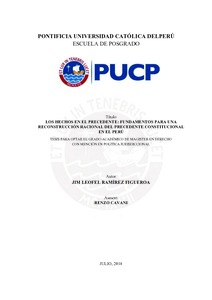Los hechos en el precedente : fundamentos para una reconstrucción racional del precedente constitucional en el Perú
Abstract
Con la puesta en vigencia del Código Procesal Constitucional se introdujo al sistema jurídico
peruano la figura del precedente constitucional vinculante. A la luz de dicha regulación, el
Tribunal Constitucional ha emitido un sin número de precedentes vinculantes, los cuales
demuestran ausencia de racionalidad en la formación de estos, principalmente por los siguientes
aspectos: formación abstracta del precedente constitucional, esto es, un precedente creado al
margen de los hechos del caso concreto; y a partir de la ausencia de conexión entre el
precedente y los hechos, se fijan como extremos vinculantes aquellos razonamientos que no son
la ratio decidendi. Bajo este contexto, cabe preguntarse: ¿Es racional el modus operandi del
Tribunal Constitucional en la formación e identificación del precedente constitucional? ¿Se
pueden interpretar los artículos VI y VII del Título Preliminar del Código Procesal
Constitucional de manera distinta a la interpretación efectuada por el Tribunal Constitucional?
Pues bien, con la expresión «precedente vinculante» se alude a la obligación que tienen los
jueces y tribunales de seguir decisiones anteriores al tomar una decisión posterior. La doctrina
del precedente, surgida en la tradición del common law, gira entorno a los hechos del caso
particular. Así, las categorías que influyen en la comprensión de su significado y alcances -ratio
decidendi, obiter dicta, distinguishing u overruling- solo pueden ser comprendidas a la luz de
los hechos que configuran el caso en el que es creado, así como los hechos del caso en el que
debe ser aplicado. A partir de ello, el precedente no es otra cosa más que la ratio decidendi
construida para decidir un caso particular. Por eso, sin hechos no hay precedente. With the enactment of the Constitutional Procedural Code, the figure of the binding
constitutional precedent was introduced to the Peruvian legal system. In light of this regulation,
the Constitutional Court has issued a number of binding precedents, which demonstrate absence
of rationality in the formation of these, mainly by the following aspects: abstract formation of
the constitutional precedent, that is, a precedent created regardless of the facts of the specific
case; and from the absence of connection between the precedent and the facts, those arguments
that are not the ratio decidendi are fixed as binding ends. In this context, it is worth asking: Is
the modus operandi of the Constitutional Court rational in the formation and identification of
the constitutional precedent? Can articles VI and VII of the Preliminary Title of the
Constitutional Procedural Code be interpreted differently from the interpretation made by the
Constitutional Court? Well, the term "binding precedent" refers to the obligation of judges and
courts to follow previous decisions when making a subsequent decision. The doctrine of
precedent, arising in the common law tradition, revolves around the facts of the particular case.
Thus, the categories that influence the understanding of their meaning and scope -ratio
decidendi, obiter dicta, distinguishing or overruling- can only be understood in the light of the
facts that make up the case in which it is created, as well as the facts of the case in which it must
be applied. From this, the precedent is nothing more than the ratio decidendi built to decide a
particular case. Therefore, without facts there is no precedent.
Temas
Precedentes judiciales--Perú
Tribunales constitucionales--Jurisprudencia--Perú
Derecho procesal constitucional
Common law
Tribunales constitucionales--Jurisprudencia--Perú
Derecho procesal constitucional
Common law
Para optar el título de
Magíster en Derecho con mención en Política Jurisdiccional
Collections
The following license files are associated with this item:






